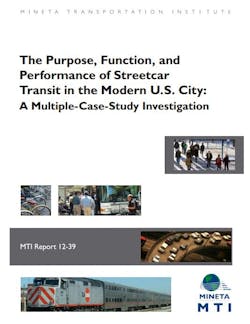How Does Streetcar Performance Compare in 5 Cities?
When cities consider building streetcar (trolley) systems, they often point to Portland OR as a guarantee of success. However, it’s not that simple. Many specific factors must be taken into account, or the project could under-perform, as it has in some other cities. That is the conclusion of the Mineta Transportation Institute’s latest peer-reviewed research report, The Purpose, Function, and Performance of Streetcar Transit in the Modern U.S. City: A Multiple Case Study Investigation. The study focused on five US cities with streetcars or trolleys. Principal investigator was Jeffrey Brown, PhD, with Hilary Nixon, PhD, and Enrique Ramos. The report can be viewed at http://transweb.sjsu.edu/project/1201.html
Brown said. “This study examines the experiences of the modern-era streetcars operated in Little Rock, Memphis, Portland, Seattle, and Tampa. We discovered that in these cities, the streetcar’s primary purpose was to be a development tool. A second objective was to be a tourism-promoting amenity, such as in Little Rock and Tampa. Transportation objectives were largely afterthoughts with the notable exception of Portland, and to a lesser degree, Seattle.”
Key informant interviews revealed that in most cities, private sector actors from the local development and downtown business communities as well streetcar advocacy groups were the key forces behind streetcar implementation. These actors did so in order to use the streetcar primarily to achieve development goals.
When assessed as transportation, Portland’s streetcar emerged as the clear standout performer with the highest ridership and service productivity and the second-most cost effective service. Portland was also the only city in which streetcar performance (service productivity and cost effectiveness) measures surpass that of the average local bus.
Based on this study, the authors made some primary suggestions for cities planning their own streetcar services:
- Think carefully about the fundamental purpose of any proposed streetcar plans. Then proceed in all decision making with that fundamental purpose clearly in mind.
- Regard the example of Portland with much more caution. Many streetcar advocates point to Portland’s experience and then assume that it could be easily replicated elsewhere.
- Realize that Portland’s experience is the result of a unique combination of external factors (local population and employment patterns, the health of the real estate market) and local decisions (land development policy decisions, financial decisions, other public investments, streetcar alignment location and length, streetcar operations decisions, streetcar fare policy decisions) that may or may not be applicable elsewhere.
In addition to an overall discussion of the research methodology and key findings, the report also includes detailed information about each city’s streetcar system. These include the best characteristics of that system; local socioeconomic context for the system; land use and development context; historical background on streetcar development; ridership and performance; insights from each key informant interview; and conclusions.
